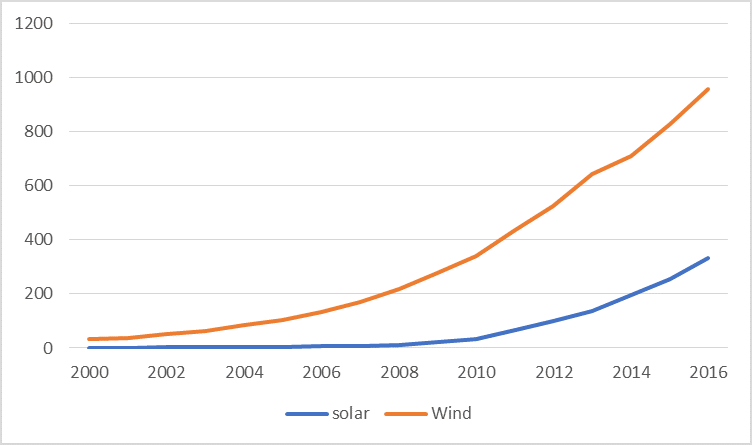Global Insight 9: 20-06-17
Australia
AEMC call for submissions on its Distribution Market Model
The Australian Energy Market Commission (AEMC), the rule maker for the National Electricity Market (NEM) has released its draft report outlining the possible future for the electricity distribution system in response to the current capacity provided by DER in the NEM. The report recognizes the role distributed generation could play in the future electricity system – optimization of DER, demand response and frequency control; and the changing role of the distribution system operator from capacity provider to market provider/facilitator. The final report will be released in August this year.
Australia’s largest privately-owned office products supplier to generate its own electricity
COS, a privately-owned office supplier has installed a total of 403kW of solar PV across its three warehouses in Sydney, Melbourne and Brisbane. This will enable it to generate around 80% of its electricity needs, and is estimating 100% should it install battery storage. Unlike investor owned businesses, this privately owned firm is able to allow for longer payback times for its initial investment but with payback for PV expected to be between 4-8 years expectations are that this could be the future for many commercial and industrial businesses. This combined with over 30% of households in South Australia and Queensland now with PV installed shows the importance of a review into the distribution model as mentioned above.
Europe
EDF tests sharing of solar PV power in France
EDF’s specialised subsidiary company ENR has launched a trial programme allowing consumers with solar panels to share the resulting electricity. Current law requires this to happen through a single legal entity which then has a contract with the distribution network operator. The programme will also face the challenge of tracking production, consumption and trade in solar output. EdF has said it will not be able to offer a mass-market service until late 2018 at the earliest.
Solar Power Europe’s calls for an industrial policy for solar
Recent data from Solar Power Europe show that while the global solar market is thriving, the pace of growth in Europe is slowing, in large part due to the cutting back of support programmes. In 2016, global solar demand increased by 50%, whereas in Europe demand decreased by over 20%. Moreover, between 2008 and 2014, solar jobs shrank from over 200,000 to less than 120,000 in Europe. SPE’s President Christian Westermeier has called for a new European-wide industrial policy to take the global lead the continent once enjoyed in solar, and building on the strong network of researchers, production equipment suppliers, raw and processing materials companies, inverter manufacturers, operations and maintenance providers, and technology providers in Europe. Westermeier estimates that the industry could provide 3000,000 jobs by 2030.
Blockchain Energy Trading Trial to be Launch in Europe
23 European power and energy trading companies have announced that later this year they will undertake a pilot energy blockchain trading project. The concept behind the pilot is to enable trading firms to buy and sell energy without going through a centralized energy market place, which will be more efficient and save money. If this pilot goes ahead as planned it will be the largest, as well as potentially the first, industrial-strength blockchain energy platform to be adopted by leading power and energy market participants
US
Smart Water Heater
Bringing vectors together remains a key challenge in decarbonising energy systems, with most focus still just on electricity. Making use of existing hot water storage in homes in a smarter energy system is an obvious step that is increasingly being used. In the latest example from Vermont a small pilot is providing new hot water heating controls along with a Nest thermostat for 99 cents/month. It’s one example of a number of projects in the US that are bringing together real-time network data and predictive analysis to turn water heaters into an energy saving and grid responsive storage device. The approach creates a new way to offer DSR into the market, with existing studies suggesting that that value of grid-responsive electric water heating could range from fifty to hundreds of dollars a year, depending on their application.
Dealing with Rapid System Change in the Californian Electricity System
In a detailed look at the California electricity market, Kathryn Porter sets outs a number of drivers of rapid change and potential lessons for markets elsewhere. Some of the issues highlighted include: how regulation has failed to keep pace with market change; how the ongoing growth of renewables is increasing the regularity of a supply/demand duck curve; how the current regulatory inertia and system change has created higher prices; and the wider disruptive nature of negative wholesale prices. Some of the possible solutions to these changes include better grid interconnection and operation, based on DERs, between different states. In addition, innovation in both technology and policy to help stabilise the market, based on moving away from a centralised approach to a more distributed system.
Wider Globe
Global Energy Intensity Increases as does renewable energy generation
BP Statistical Review of World Energy 2017 showed some important new global trends. Firstly, on energy efficiency, as while global GDP grew by 3% in 2016, energy consumption only increased by 1%, almost half of the average rate of the last decade. In the OECD energy demand only increased by 0.2%, while in China, once the driver of global energy demand increase, only saw a 1.3% increase (one quarter of its average over the last decade). Secondly, there was variation in the consumption patterns of fossil fuels, with increases in oil and gas consumption, by 1.6% and 1.5% respectively, but a fall in the global consumption of coal (of 1.7%). Furthermore, the use of renewable energy continues to grow rapidly and in 2016, wind consumption increased by 15.6% and solar 29.6%. While their share of global primary energy consumption remains small 3% (5% of electricity), renewables strong growth meant they accounted for over 30% of the increase in primary energy. As the figure shows there has been consistent and significant growth in renewables over the last decade
Solar and Wind Produced Electricity (TWh)
What if EVs take off like solar?
This was the question asked in a think piece on energy & carbon recently. It highlighted that solar installations a decade ago where around 1.5GW globally and that this year they will be over 80GW. If EVs sales next year hit 1.5m and it grows anything like solar, they suggest that by 2028 we will have over 250m EV cars across the world. They accept that there are range of uncertainties about the number and timing of deployment in EVs, but argue it is not a question of if, but of when. They flag that many of the European utilities who are currently struggling that dismissed the idea of a solar boom, so the idea of a boom in EVs is not far-fetched. The blog finishes with some interesting implications on exponential growth in EVs on our roads – change can happen quickly and its implications can be large.
Related Posts
« Previous Comparing NYS with CA: Blog 5 – A CA and NYS similarity: mapping DER via a regulated process Comparing NYS with CA: Blog 6- DSO or DSP – why it is the function rather than the name that really matters Next »








